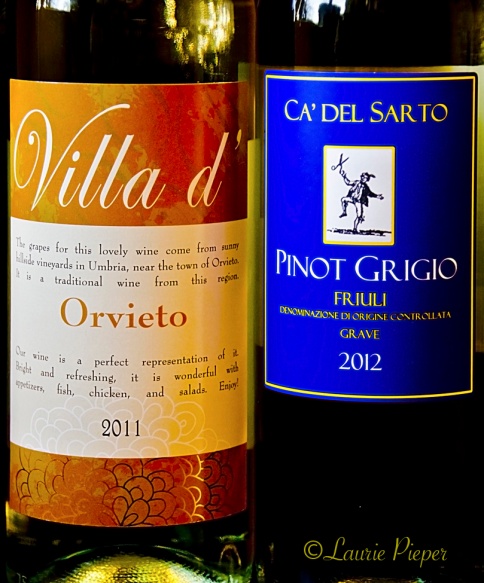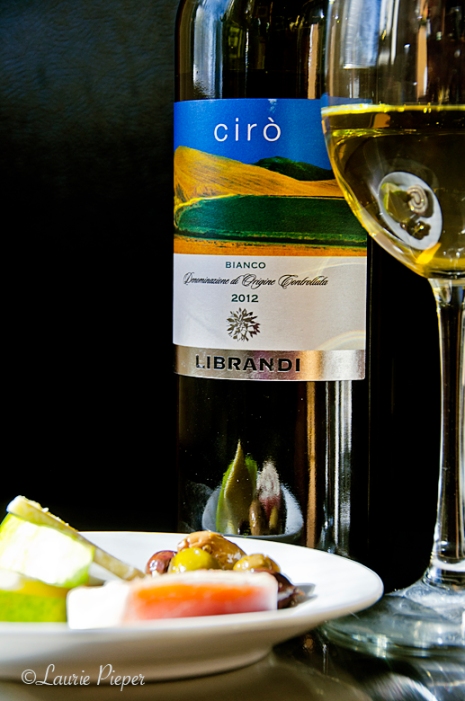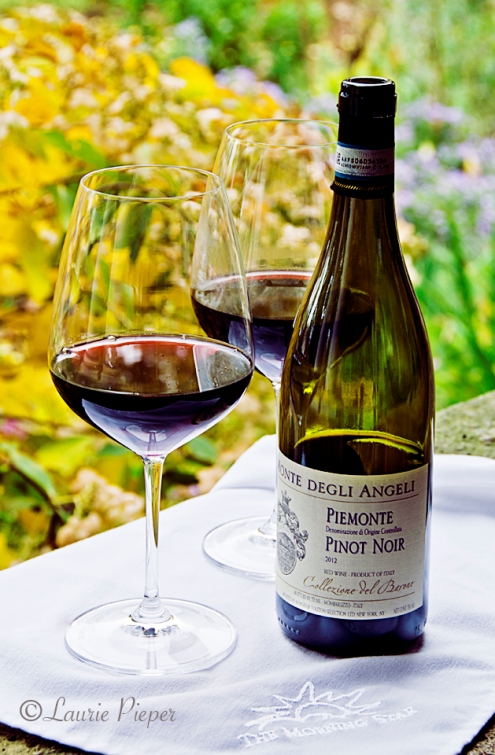Part I: A Memorable Meal
For years, friends and family told me that I needed to take a vacation. I finally accepted their advice and took myself on a trip to Las Vegas – my goals being to visit family, eat really good meals, and do some Christmas shopping. I actually succeeded in all three of those things!
My first night there, I had dinner at B&B Ristorante, owned by Mario Batali and Joseph Bastianich. Since I was dining alone, I ate at the bar which gave me the opportunity to people watch and chat with other patrons; but more importantly, it gave me the opportunity to discuss the menu and wine pairings with the bartender, Jason. Though I was already familiar with a few Italian wines, I felt a bit lost looking at the extensive wine list. So once I decided what I wanted to eat, I was happy to let Jason chose a selection of wines to go with my meal. (At a really good restaurant, the bartender knows a lot more than just how to mix cocktails.)
I started off with a glass of Ca’ del Bosco Franciocorta Cuvée Prestige – a delightful Champagne-style sparkling blend of Chardonnay, Pinot Nero and Pinot Bianco – then ordered a beet salad and grilled Branzino. To go with the salad Jason poured Bastianich Rosato, a pleasingly crisp, light rosé. To go with the fish, he poured Marziano Abbona Roero Arneis Orchietti – a medium bodied white wine with a gorgeous floral bouquet. After waiting a little bit after the meal, at Jason’s suggestion I enjoyed a plate of dolci with a taste of two amari: Cardamaro Vino Amaro – a moscato-based liqueur with a sweet start and bitter finish; and then Amaro Ci0Ciaro – a liqueur with bitter orange and herbal flavors. As was my expectation, the food was delicious, each dish being cooked just right and the flavors being perfectly balanced; and the wines and liqueurs were exactly right for the meal.
Part II: A “Tour” Back Home
When I returned to Kansas, I had a conversation with Chad Lohman, C.S., owner of Nespor’s Wine and Spirits about how much I enjoyed the wines and liqueurs that I had at B&B. Chad suggested that I might appreciate a “tour” of the Nespor’s Italian wines section in connection with thinking about wines for the holiday season. Even though I hadn’t yet starting planning our Christmas menu, I certainly thought a tour sounded like a great idea!
Our premise was that Italian wines, like French wines, are made to be enjoyed with a meal and so pair well with food. As we started our tour with a discussion of a Sicilian white wine, we also talked about the fact that white wines are frequently overlooked during the winter because people feel like they don’t want a glass of cold wine. This is unfortunate because white wines often pair more easily with food than red wines, as reds can sometimes be overpowering. Moreover, white wines lose their interest when they are overchilled, so serving whites in winter shouldn’t be a worry. Rather the concern should be whether the wine goes with the food (or vice versa).
Since I didn’t have a particular menu in mind when Chad and I were having our conversation, we talked mostly in terms of generalizations. One general rule is that except for with dessert, dry sparkling wines pair well with almost any food. Sweeter foods, on the other hand, require sweeter wines – the sweeter the food, the sweeter the wine. Another guideline is that the heavier the food, the darker and fuller bodied the wine should be. Keeping in mind that the lighter wines in each category would generally go with the lighter foods in that catergory, this guideline would recommend the following:
• white wines pair well with lighter vegetables (e.g. green salad), lighter cheeses (e.g. mozzarella), fish/seafood (e.g. shrimp) and lighter poultry (e.g. chicken);
• rosés pair well with almost everything but especially with richer vegetables (e.g. beets), medium cheeses (e.g. fontina), heavier fish/seafood (e.g. tuna), darker poultry (e.g. duck) and lighter meats (e.g. prosciutto);
• red wines pair well with red sauces, stronger cheeses (e.g. romano), roasted/grilled vegetables or heavier vegetable stews, darker poultry (e.g. pheasant), lighter meats (e.g. ham) and heavier meats (e.g. beef).
These generalizations can then be refined in two ways.
First, it can be helpful to think about both foods and wines in terms of the regions with which they are associated because generally speaking, the wines of each region are made to go with its cuisine. Pairing foods and wines on a regional basis requires having some knowledge about the various regional cuisines. For example, consider a seafood dish such Scampi cooked in olive oil with garlic and herbs. This is a dish that is associated with the Friuli-Venezia area, so a white wine from this area would be something one might consider as a complement to the dish. Chad recommends Villa d’Orvietto (Grechetto, Prociano, and Malvasia) and Ca’ del Sarto Pinot Grigio as nice wines from this region, but suggests avoiding wines coming out of the more industrial areas around Venice.
Another way that one can refine the generalizations that I mentioned above is to think more specifically about the flavors of the dishes that one is preparing (or ordering). For example, is the dish mild, buttery, creamy, earthy, salty, spicy, citrusy, sour, or smoky? To pair wines with the more specific flavors in foods, it is helpful to have more extensive knowledge about particular wines. One might ask of a wine whether it is light or full-bodied. (Color isn’t always a perfect guide.) Is it fruity, spicy, acidic, tannic, oaky? Is it dry or sweet or something in between? Is it sparkling or flat? Most importantly, the question one will want to ask oneself is, “Do I like this wine?”
For example, I tried three of the whites that Chad had recommended from southern Italy with several different foods. The three that I tried were Ciró Bianco Librandi 21012 (Greco Bianco), Falanghina Feudi di Sangregorio 21012, and Regaleali Bianco Sicilia 2011 (an Inzolia, Cataratto and Greciano blend).
All were light and crisp, as Chad had said they would be; but the Ciró Bianco Librandi, which I have had several times before, was my favorite. I thought that it went well with a wider range of foods than the other two, but mostly I enjoyed its flavor more – fruity peach and lightly spicy, without being sweet. The Regaleali was the lightest of the three and went nicely with pears and with smoked salmon canapés. The Feudi di Sangregorio paired well with the olives, but seemed a little bitter with lighter foods. Mostly, the Librandi just appealed to my taste more than the other two. Enjoying the wine is the point, afterall, which means that no matter how much research one does, ultimately, one has to taste the wine and decide whether one likes it.
Continuing with the tour … We chatted about the reds (the Barbara d’Astis, Barolos, Barbarescos, Barberas, Dolcettos, and Brachettos) and whites (the Arneises and Asti Spumantes) of Piedmont and also about the Sangiovese-based Chiantis and super Tuscans of Tuscany – Chad generously sharing his time and knowledge, me reading labels and taking notes.
After, when I went home and started reading about the wines, I felt overwhelmed by all of the grape varieties with which I wasn’t familiar by name (Falanghina, Guillot, Primitivo, Nero d’Avola, Gretchetto, Malvasia, Nebbiolo, and so forth) not to mention the styles of wine between which I didn’t know the differences. Obviously, I had some work to do, if I was going to learn more about Italian wines. So I went to the library and checked out Vino Italiano: The Regional Wines of Italy by Joseph Bastianich (of B&B Ristorante) and David Lynch. The first section I read was about the difficulty of growing wines in Ciró and one wine that the authors recommended from that region was the Librandi. Ah, confirmation that I was on the right track.
Then it came to me. The tour that Chad had given me really laid out a large project for me to embark upon, if I was up to the task … getting to know the wines of Italy well enough to converse about them intelligently and to pair them skillfully with food. And if you know me, you know that this is exactly the type of project that I love. I’ve tried about 20 Italian wines so far – thank goodness for wine tastings – and have several good resources that I can rely upon to help guide me further. Hmmm … I’m thinking that there might be another vacation sometime in my future – perhaps, Italy!
Salute!
Part III: Addendum: A few more of Chad’s Recommendations
Poggia Anima Uriel (white) Grillo
Stemmari 2012 (red), Nero d’Avola
Amano 2009 (red), Primitivo
Monte degli Angeli Pinot Noir 2012 (red) Pinot Noir
Produttori del Barbaresco 2007 (red) Nebbiolo
Poggia Anima Belial 2011 (red) Sangiovese
Villa Cafaggio 2010 Basilica Single Estate (red), Sangiovese
Molino di Sant’antimo 2008 Brunello di Montalchio DOCG (red), Sangiovese
Basciano Chianti Rufina 2010 (red blend), Sangiovese, Colorino
Tolaini Al Passo 2009 (red blend), Sangiovese, Merlot
Tolaini Valdisanti 2009 (red blend), Cabernet Sauvignon, Sangiovese, Cabernet Franc
Villa Jolanda Brachetto (sweet red) Brachetto





Pingback: Italian Wine Regions (1) | MyWine Channel
Excellent advice, specifically: talk with people who know the wines and how your taste can belnd with a meal and wine. Whenever we travel, we seek out wine tastings, and talk with the restaurant staff about combinations. I will admit that my taste buds are somewhat more cultured that our meat-and-potatoe style food here in the USA, but I cannot claim to tell the difference between a 2009 and 2011 vintage of some vintage. One criteria that I like to talk with my local wine merchant about is the event for the wine. He will ask, “Is this a Thursday night at home meal? Weekend gathering of friends? Anniversary?” Obviously the the bottle for each meal will be different. No need to spend $$$$ on Thursday night, or diminish the anniversary with a $ bottle that would be fine otherwise.
Oscar
Hello, Oscar.
It is good that you have a wine merchant whose advice you can trust.
I hope that you are enjoying the time off that the weather conditions have granted you.
Laurie
Great info — thanks so much!
Glad that you liked the article! Thanks for the note!
Laurie, you have had quite the tour. So many wines to try, so little time. Thanks for bringing us along.
Thank you for your note, Ron. It is fun to have a different project : )
Have a nice evening!